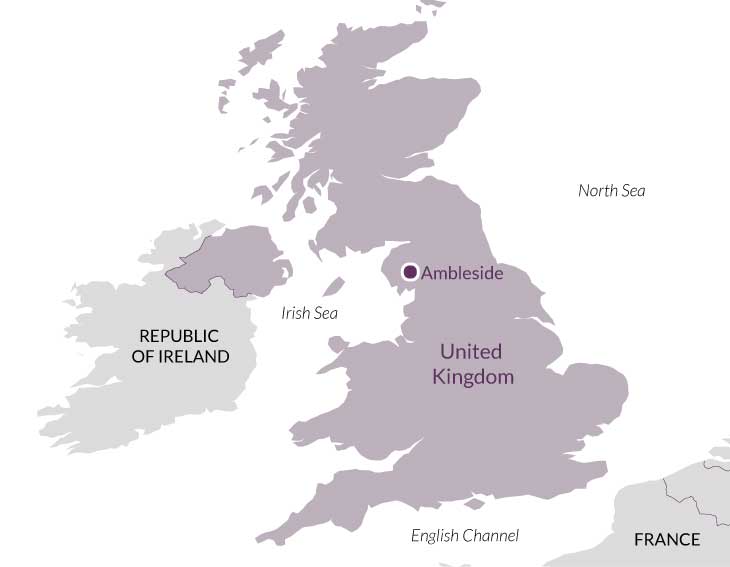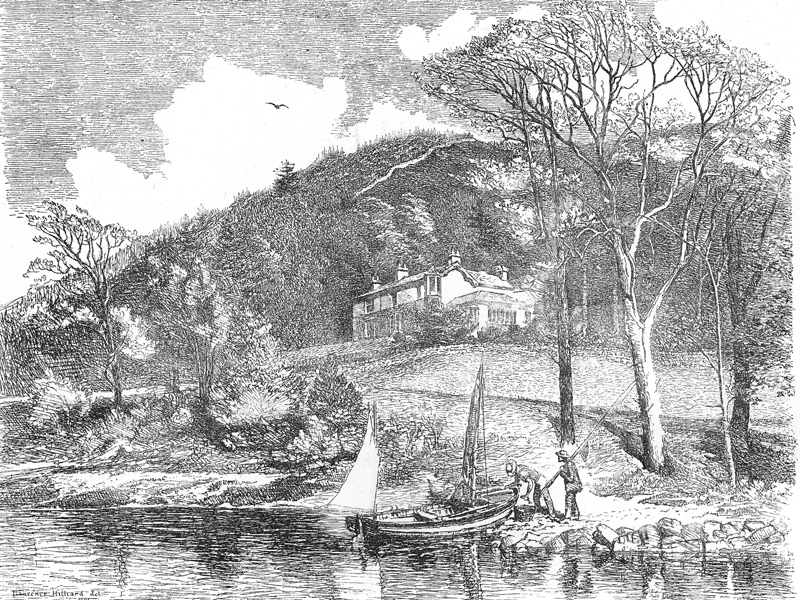Overview
For centuries the Lake District has been regarded as one of the most naturally beautiful landscapes of the British Isles. Seen on a map, the pattern of the lakes themselves, which spread outwards from an upland centre, explains the massif’s formation in the course of successive ice ages when glaciers gouged the ancient rocks to create radiating valleys and lakes.
The second half of the 18th century saw the cult of the picturesque lead increasing numbers of men and women to travel in search of sublime beauty, by which was meant an aspect of the landscape that was seen to be free of human agency and where people could feel the force of its elemental power. For William and Dorothy Wordsworth, who settled at Grasmere in 1799, it was the actuality of the Lakeland countryside that was so wonderful. The Prelude, which chronicles the poet’s upbringing at Cockermouth and as a boy in Hawkshead, describes a landscape in which the rural folk live in harmony with nature.
Ruskin was taken to the Lakes as a child (a visit which he memorialised in his account of the sight of Derwent Water from Friar’s Crag), and all his life he celebrated landscape forms which were untrammelled and without trace of man’s destructive interference. In 1871 he bought a house on the eastern shore of Coniston Water, and here he died in 1900.
The principle of ‘truth to nature’, expounded by Ruskin as a precept for artists, was understood by the young Beatrix Potter as she learnt to paint and draw natural specimens. In 1882 she met the Rev’d Canon Rawnsley, who was in turn a friend of Ruskin’s, and who cared passionately about the Lakes, fearing that uncontrolled development and transport links would destroy the essential qualities of remoteness and tranquility. The commercial success of Peter Rabbit allowed her to buy the first of her Lakeland properties, Hill Top, in 1905. She acquired farms and larger estates where traditional management methods were to be used and the beauty of landscape and vernacular architecture respected. Beatrix Potter’s bequest to the National Trust at her death in 1943 consisted of 14 Lakeland farms covering an area of 4,000 acres.
Wordsworth, Ruskin and Potter form a linked succession of people who loved the Lakes. Each found their own expression of the particular beauty of this part of England, in poetry and prose, and in art. At the same time, these three far-sighted individuals knew how important it was to protect the physical landscape and the way of life of the Lakes, and each was influential in fostering a culture of preservation. We will visit places associated with them and as we walk, consider their achievement in safeguarding such an extraordinary natural setting.
Day 1
Lancaster, Ambleside. The coach leaves Lancaster Railway Station at 2.00pm. The Ruskin Library at Lancaster, built by Richard MacCormac in 1998 houses the collection of Ruskin drawing and archive material formed by John Howard Whitehouse. Drive to Ambleside where all six nights are spent.
Day 2
Grasmere, Rydal Mount. A full day in the footsteps of Wordsworth. We start the day with a lecture at the Jerwood Centre where the Wordsworth Trust is based and visit Dove Cottage, the Wordsworths’ first Lakes home which subsequently belonged to Thomas de Quincey. A short walk to Grasmere and St Oswald’s Church, where the graves of Wordsworth and his family are found. After lunch walk from Grasmere on the exact path Wordsworth would have followed to his home at Rydal Mount. This is a short, easy walk, although the undulating trail is steep in places and overlooks Rydal Water (1.5 miles, c. 40 minutes). Rydal Mount was the Wordsworth family home from 1813–50. This elegant house and fine gardens welcomed many literary visitors.
Day 3
Keswick, Crossthwaite, Cockermouth. An easy walk along the eastern shore of Derwentwater to Keswick (1.8 miles, c. 1 hour). With excellent views across the lake, the path is carefully maintained and mostly flat. Greta Hall, a fine house with classical detail of the late 18th century was lived in by Samuel Taylor Coleridge. Visit St Kentigern Parish Church, the burial place of poet laureate Robert Southey and the Rev’d Canon Rawnsley. Wordsworth House was the birthplace of both William and Dorothy Wordsworth, whose father was the agent of the 1st Earl of Lonsdale which entitled him the occupancy of this very grand house.
Day 4
Coniston, Brantwood. Visit Ruskin’s Grave and the Ruskin Museum, opened in 1901 shortly after his death. There is much material of Ruskinian association including beautiful drawings and the diagrams made to illustrate his lectures. Take the ferry across Lake Coniston, the setting for Arthur Ransome’s novel Swallows and Amazons, and the best way to arrive at Brantwood, Ruskin’s home from 1872 till his death. The house has an extensive literary history and a major collection of Ruskin’s drawings, paintings, and scientific collections. An easy afternoon walk on mostly level footpaths and country tracks, gentle underfoot, with a short ascent from Brantwood through the restored walled garden to Monks Coniston at the shore of Coniston Water (2 miles, c. 1 hour).
Day 5
Wray Castle, Hawkshead, Hilltop. A fantastic and huge Victorian, castellated, pretend fortress built in the 1840s for a wealthy surgeon from Liverpool. This was the first holiday house to be rented by the parents of Beatrix Potter, in the summer of 1882. The scale and pretentiousness of the building make fascinating comparison with the modestly authentic Lakeland cottages that she was later to live in and conserve. An easy, mostly flat walk along the western shore of Windermere, through woodland and fields, culminating at Claife Viewing Station, a Victorian purpose-built monument to appreciate the landscape (2.5 miles c. 1 hour, 15 minutes). In Hawkshead, visit the grammar school Wordsworth attended, now a museum, and the Beatrix Potter Gallery as well as Hill Top, Beatrix Potter’s 17th-century farm house.
Day 6
Holehird, Windermere, Troutbeck. Set 17 acres above Windermere, Holehird Gardens are some of the finest gardens in England and home to the national collections of Astilbe, Hydrangea and Polystichum Ferns. A short walk along grassy paths through fields graded moderate for its steep ascents in places up to Orrest Head, at 784 feet above sea level, with magnificent views over Lake Windermere and up to the Langdale fell (2.5 miles, c. 1 hour). Visit Troutbeck, a 17th-century farmhouse lived in by a long established and intermittently prosperous gentry family. The east window at Jesus Church is one of the crowning glories of Morris, Marshall, Falkner & Co., showing events from the Life of Christ, and made in 1873.
Day 7
Ambleside, Blackwell, Kendal. Explore Ambleside; highlights include the parish church of St Mary’s, built by George Gilbert Scott. The Armitt Library has in its collections a large group of important drawings by Beatrix Potter, bequeathed by her to the museum at her death, including extraordinary and very beautiful studies of natural history specimens and archaeological finds. Blackwell is a house built in the Arts and Crafts style by M.H. Baillie Scott in the last years of the 19th century for the mayor of Manchester, the brewer Sir Edward Holt. The tour ends at Kendal Station by 3.00pm.
Price
Two sharing: £2,560. Single occupancy: £2,940.
Included
Private coach throughout; hotel accommodation; breakfasts, 1 lunch and 4 dinners with wine, water, coffee; all admissions; all tips; the services of the lecturer and tour manager.
Accommodation
Waterhead, Ambleside: 4-star modern, comfortable hotel on the shore of Lake Windermere.
How strenuous?
This is a walking tour, graded easy. There are 5 walks of which 4 are easy and around an hour in length, 1 is moderate with some short but steep uphill sections. Terrain can be uneven and slippery in wet weather. It is essential for participants to have appropriate walking footwear, be in good physical condition and to be used to country walking with uphill and downhill content. Average distance by coach per day: 24 miles.
Are you fit enough to join the tour?
Group size
Between 10 and 22 participants.

'It was well-planned and the walking was not too arduous, with plenty of time to enjoy the surroundings en route.'
'Everyone in the group was so friendly and interesting. I had been slightly apprehensive about being a lone traveller, but there really was no need.'
'A very enjoyable holiday with a well thought out combination of walks and visits.'
'Very interesting itinerary - the right mix of literature and walking and time to enjoy it all and absorb everything including the beautiful scenery.'
'This tour was magical with the culture, walking and warm sunshine in the beautiful English Lake District. A delight to remember.'
